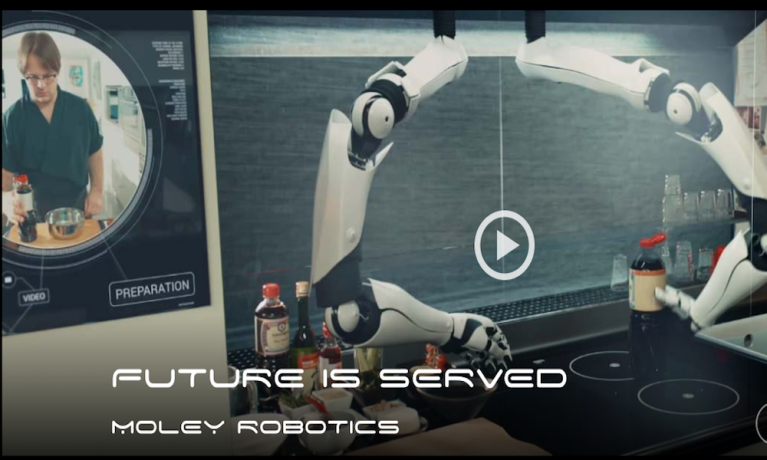Moley And Robo Chef Magic

An oft-made complaint in the era of smart machines and advanced robotics is why we all still have to do so much housework of our own. Sure, the washer-dryer combo in the laundry room may be started and stopped virtually — and even send real-time messages about the laundry’s progress. But when it comes time to move the load from the washer to the dryer, old-fashioned manual labor is necessary.
This is something of a trend across the smart-tech milieu. Connected smart appliances can make it easier for consumers to do things better, but they can’t do many things for the consumer other than flip the lights on and off. The smart fridge can tell consumers that they’re out of butter. The smart oven can warn that the cookies are in danger of burning. But breaking eggs, chopping onions or tossing a salad is still a human task.
Until it isn’t anymore.
This leads us to Moley, a London-based robotics firm that wants to offer up a special helper for the kitchen — a robot that can actually do the cooking.
The robot is trained by watching human chefs do their work, specifically focused on their exact movements while chopping, stirring, whisking and so on. Once the machine captures those movements, it programs them into commands that then drive its robotic hands.
“You tell it to do something — whether it’s a bit of prep or completing a whole dish from start to finish — and it will do it. And it will do it the same every single time,” Moley CEO Mark Oleynik said.
The Moley device, he said, is not designed as industrial hardware meant to live in professional kitchens. It doesn’t work at blinding speed or incorporate unusual techniques. In fact, he noted, the device is designed to move the way its owner moves — because it learns how to cook new things by watching how its operator makes them first.
But the goal, Oleynik said, is not just to build the device and set it forth on the marketplace for the technology-enthused customer.
“Our dream is not only to introduce the fully automated Moley robotic kitchen into the marketplace, but to bring the cost down to a point where is affordable for the middle class. I am personally entirely confident we will make this dream a reality,” he said.
That reality may be a ways off, since the estimated market price for the Moley robo-kitchen assembly is still in the $10,000 to $15,000 range — squarely out of most middle-class consumers’ price range.
But that, Oleynik said, is today, and the early days of any technology are always the most expensive. But, he said, given the number of people who dread having to prep a family meal every night, he believes the technology will mature, become more widespread and become cheaper to manufacture — and thus sell — as it builds out to scale.
The Moley device is very complicated — particularly its “hands,” which require 20 motors, 24 joints and 129 sensors to mimic the movements of human hands. They are complex to build — and that is only the start. The system, according to Olenyik, is also built around a variety of safety features. It can’t be turned on without a biometric scan. A screen must be in place for it to operate. And it won’t record or prepare recipes if it believes they present a contamination risk.
And the system, he noted, can learn. Both from its owner, in watching and recording the meals he or she makes, and also through its connection to a network of chefs from which it can download new recipes.
“We intend to work with anyone who has the desire, and the ability, to cook,” he said. “Our interface for recording recipes will be friendly and easy to operate. The model that we are working on is a platform for collective creativity and knowledge. You can sell your recipe or give it away for free. If you are a talented chef, what could be better than introducing your dishes to a broad audience?”
As for the critique that Moley and like devices will kill cooking as surely as typing killed cursive, Olyenik is doubtful.
“Moley does not take away the knowledge and the ability of people to cook,” he said. “On the contrary. Moley accumulates human knowledge. If you cook something truly unique, the robot will record the recipe precisely, and it will keep it for future generations to reproduce.”